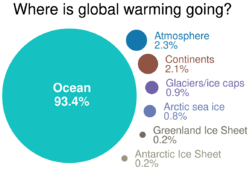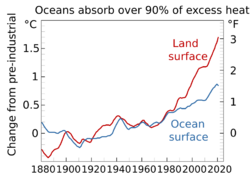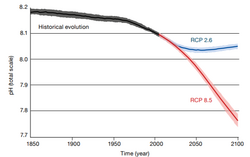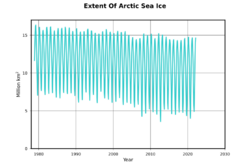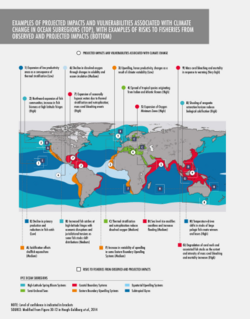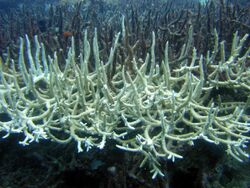Table of Contents
- 1 Changes due to rising greenhouse gas levels
- 2 Effects on the physical environment
- 3 Time scales
- 4 Impacts on marine life
- 5 Potential feedback effects
- 6 See also
- 7 References
- 8 External links Categories
- Main page: Earth:Sea level rise
- Main page: Earth:Ocean deoxygenation
- Blue carbon
- Carbon sequestration
- Effects of climate change on island nations
- Effects of climate change on the water cycle
- Special Report on the Ocean and Cryosphere in a Changing Climate (2019)
- Sustainable fisheries
- ↑ Käse, Laura; Geuer, Jana K. (2018). "Phytoplankton Responses to Marine Climate Change – an Introduction". YOUMARES 8 – Oceans Across Boundaries: Learning from each other. pp. 55–71. doi:10.1007/978-3-319-93284-2_5. ISBN 978-3-319-93283-5.
- ↑ 2.0 2.1 2.2 2.3 2.4 2.5 2.6 2.7 2.8 2.9 "Summary for Policymakers". The Ocean and Cryosphere in a Changing Climate. 2019. pp. 3–36. doi:10.1017/9781009157964.001. ISBN 978-1-00-915796-4. https://www.cambridge.org/core/services/aop-cambridge-core/content/view/097A895553D86981DFE6195ADFD3DDA4/stamped-9781009157971pre2_3-36.pdf/summary-for-policymakers.pdf. Retrieved 2023-03-26.
- ↑ Cheng, Lijing; Abraham, John; Hausfather, Zeke; Trenberth, Kevin E. (11 January 2019). "How fast are the oceans warming?". Science 363 (6423): 128–129. doi:10.1126/science.aav7619. PMID 30630919. Bibcode: 2019Sci...363..128C.
- ↑ 4.0 4.1 4.2 4.3 4.4 4.5 Doney, Scott C.; Busch, D. Shallin; Cooley, Sarah R.; Kroeker, Kristy J. (2020-10-17). "The Impacts of Ocean Acidification on Marine Ecosystems and Reliant Human Communities" (in en). Annual Review of Environment and Resources 45 (1): 83–112. doi:10.1146/annurev-environ-012320-083019.
 Text was copied from this source, which is available under a Creative Commons Attribution 4.0 International License
Text was copied from this source, which is available under a Creative Commons Attribution 4.0 International License
- ↑ 5.0 5.1 5.2 5.3 5.4 5.5 5.6 5.7 5.8 Bindoff, N.L., W.W.L. Cheung, J.G. Kairo, J. Arístegui, V.A. Guinder, R. Hallberg, N. Hilmi, N. Jiao, M.S. Karim, L. Levin, S. O'Donoghue, S.R. Purca Cuicapusa, B. Rinkevich, T. Suga, A. Tagliabue, and P. Williamson, 2019: Chapter 5: Changing Ocean, Marine Ecosystems, and Dependent Communities . In: IPCC Special Report on the Ocean and Cryosphere in a Changing Climate [H.-O. Pörtner, D.C. Roberts, V. Masson-Delmotte, P. Zhai, M. Tignor, E. Poloczanska, K. Mintenbeck, A. Alegría, M. Nicolai, A. Okem, J. Petzold, B. Rama, N.M. Weyer (eds.)]. In press.
- ↑ Freedman, Andrew (29 September 2020). "Mixing of the planet's ocean waters is slowing down, speeding up global warming, study finds". The Washington Post. https://www.washingtonpost.com/weather/2020/09/29/global-ocean-layers-warming/.
- ↑ 7.0 7.1 Cheng, Lijing; Trenberth, Kevin E.; Gruber, Nicolas; Abraham, John P.; Fasullo, John T.; Li, Guancheng; Mann, Michael E.; Zhao, Xuanming et al. (2020). "Improved Estimates of Changes in Upper Ocean Salinity and the Hydrological Cycle". Journal of Climate 33 (23): 10357–10381. doi:10.1175/jcli-d-20-0366.1. Bibcode: 2020JCli...3310357C.
- ↑ Chester, R.; Jickells, Tim (2012). "Chapter 9: Nutrients oxygen organic carbon and the carbon cycle in seawater". Marine geochemistry (3rd ed.). Chichester, West Sussex, UK: Wiley/Blackwell. pp. 182–183. ISBN 978-1-118-34909-0. OCLC 781078031. https://www.wiley.com/en-us/Marine+Geochemistry%2C+3rd+Edition-p-9781118349090. Retrieved 2022-10-20.
- ↑ Briand F., ed (2013). "Marine Extinctions: Patterns and Processes - an overview." (in en). CIESM Workshop Monographs 45: 5–19. https://www.researchgate.net/publication/271767063.
- ↑ Top 700 meters: Lindsey, Rebecca; Dahlman, Luann (6 September 2023). "Climate Change: Ocean Heat Content". National Oceanic and Atmospheric Administration (NOAA). https://www.climate.gov/news-features/understanding-climate/climate-change-ocean-heat-content. ● Top 2000 meters: "Ocean Warming / Latest Measurement: December 2022 / 345 (± 2) zettajoules since 1955". National Aeronautics and Space Administration. https://climate.nasa.gov/vital-signs/ocean-warming/.
- ↑ "The Oceans Are Heating Up Faster Than Expected". scientific american. https://www.scientificamerican.com/article/the-oceans-are-heating-up-faster-than-expected/.
- ↑ "Global Annual Mean Surface Air Temperature Change". NASA. https://data.giss.nasa.gov/gistemp/graphs_v4/.
- ↑ 13.0 13.1 13.2 Cheng, Lijing; Abraham, John; Trenberth, Kevin E.; Fasullo, John; Boyer, Tim; Mann, Michael E.; Zhu, Jiang; Wang, Fan et al. (2023). "Another Year of Record Heat for the Oceans" (in en). Advances in Atmospheric Sciences 40 (6): 963–974. doi:10.1007/s00376-023-2385-2. ISSN 0256-1530. PMID 36643611.
 Text was copied from this source, which is available under a Creative Commons Attribution 4.0 International License
Text was copied from this source, which is available under a Creative Commons Attribution 4.0 International License
- ↑ 14.00 14.01 14.02 14.03 14.04 14.05 14.06 14.07 14.08 14.09 14.10 Fox-Kemper, B., H.T. Hewitt, C. Xiao, G. Aðalgeirsdóttir, S.S. Drijfhout, T.L. Edwards, N.R. Golledge, M. Hemer, R.E. Kopp, G. Krinner, A. Mix, D. Notz, S. Nowicki, I.S. Nurhati, L. Ruiz, J.-B. Sallée, A.B.A. Slangen, and Y. Yu, 2021: Chapter 9: Ocean, Cryosphere and Sea Level Change . In Climate Change 2021: The Physical Science Basis. Contribution of Working Group I to the Sixth Assessment Report of the Intergovernmental Panel on Climate Change [Masson-Delmotte, V., P. Zhai, A. Pirani, S.L. Connors, C. Péan, S. Berger, N. Caud, Y. Chen, L. Goldfarb, M.I. Gomis, M. Huang, K. Leitzell, E. Lonnoy, J.B.R. Matthews, T.K. Maycock, T. Waterfield, O. Yelekçi, R. Yu, and B. Zhou (eds.)]. Cambridge University Press, Cambridge, United Kingdom and New York, NY, USA, pp. 1211–1362
- ↑ Gille, Sarah T. (2002-02-15). "Warming of the Southern Ocean Since the 1950s". Science 295 (5558): 1275–1277. doi:10.1126/science.1065863. PMID 11847337. Bibcode: 2002Sci...295.1275G.
- ↑ Cheng, Lijing; Abraham, John; Zhu, Jiang; Trenberth, Kevin E.; Fasullo, John; Boyer, Tim; Locarnini, Ricardo; Zhang, Bin et al. (February 2020). "Record-Setting Ocean Warmth Continued in 2019" (in en). Advances in Atmospheric Sciences 37 (2): 137–142. doi:10.1007/s00376-020-9283-7. Bibcode: 2020AdAtS..37..137C.
- ↑ Ritchie, Roser, Mispy, Ortiz-Ospina. "SDG 14 - Measuring progress towards the Sustainable Development Goals ." SDG-Tracker.org, website (2018).
- ↑ Gattuso, J.-P.; Magnan, A.; Billé, R.; Cheung, W. W. L.; Howes, E. L.; Joos, F.; Allemand, D.; Bopp, L. et al. (3 July 2015). "Contrasting futures for ocean and society from different anthropogenic CO 2 emissions scenarios". Science 349 (6243): aac4722. doi:10.1126/science.aac4722. PMID 26138982. http://plymsea.ac.uk/id/eprint/6491/1/Gattuso%20et%20al.pdf. Retrieved 21 November 2022.
- ↑ "Climate Change Indicators: Sea Level / Figure 1. Absolute Sea Level Change". U.S. Environmental Protection Agency (EPA). July 2022. https://www.epa.gov/climate-indicators/climate-change-indicators-sea-level. "Data sources: CSIRO, 2017. NOAA, 2022."
- ↑ 20.0 20.1 Nicholls, Robert J.; Lincke, Daniel; Hinkel, Jochen; Brown, Sally; Vafeidis, Athanasios T.; Meyssignac, Benoit; Hanson, Susan E.; Merkens, Jan-Ludolf et al. (2021). "A global analysis of subsidence, relative sea-level change and coastal flood exposure" (in en). Nature Climate Change 11 (4): 338–342. doi:10.1038/s41558-021-00993-z. Bibcode: 2021NatCC..11..338N. https://zenodo.org/record/4621313. Retrieved 2022-11-21.
- ↑ 21.0 21.1 Trujillo, Alan P. (2014). Essentials of oceanography. Harold V. Thurman (11th ed.). Boston: Pearson. ISBN 978-0-321-81405-0. OCLC 815043823.
- ↑ Talley, L. (2000). Sio 210 talley topic 5: North Atlantic circulation and water masses. thermohaline forcing .
- ↑ 23.0 23.1 Trenberth, K; Caron, J (2001). "Estimates of Meridional Atmosphere and Ocean Heat Transports". Journal of Climate 14 (16): 3433–43. doi:10.1175/1520-0442(2001)014<3433:EOMAAO>2.0.CO;2. Bibcode: 2001JCli...14.3433T. https://zenodo.org/record/1234671. Retrieved 2022-10-28.
- ↑ 24.0 24.1 24.2 Chester, R.; Jickells, Tim (2012). "Chapter 9: Nutrients oxygen organic carbon and the carbon cycle in seawater". Marine geochemistry (3rd ed.). Chichester, West Sussex, UK: Wiley/Blackwell. ISBN 978-1-118-34909-0. OCLC 781078031. https://www.wiley.com/en-us/Marine+Geochemistry%2C+3rd+Edition-p-9781118349090. Retrieved 2022-10-20.
- ↑ Chan, Francis; Barth, John; Kroeker, Kristy; Lubchenco, Jane; Menge, Bruce (1 September 2019). "The Dynamics and Impact of Ocean Acidification and Hypoxia: Insights from Sustained Investigations in the Northern California Current Large Marine Ecosystem". Oceanography 32 (3): 62–71. doi:10.5670/oceanog.2019.312. 50px Material was copied from this source, which is available under a Creative Commons Attribution 4.0 International License .
- ↑ Gewin, Virginia (August 2010). "Oceanography: Dead in the water". Nature 466 (7308): 812–814. doi:10.1038/466812a. PMID 20703282.
- ↑ 27.0 27.1 Li, Guancheng; Cheng, Lijing; Zhu, Jiang; Trenberth, Kevin E.; Mann, Michael E.; Abraham, John P. (December 2020). "Increasing ocean stratification over the past half-century". Nature Climate Change 10 (12): 1116–1123. doi:10.1038/s41558-020-00918-2. Bibcode: 2020NatCC..10.1116L. https://scholarsphere.psu.edu/resources/b5e27d36-d40c-428c-bfc7-32646be12f5c. Retrieved 2022-10-21.
- ↑ 28.0 28.1 Breitburg, Denise; Levin, Lisa A.; Oschlies, Andreas; Grégoire, Marilaure; Chavez, Francisco P.; Conley, Daniel J.; Garçon, Véronique; Gilbert, Denis et al. (5 January 2018). "Declining oxygen in the global ocean and coastal waters". Science 359 (6371): eaam7240. doi:10.1126/science.aam7240. PMID 29301986. Bibcode: 2018Sci...359M7240B.
- ↑ 29.0 29.1 Oschlies, Andreas; Brandt, Peter; Stramma, Lothar; Schmidtko, Sunke (2018). "Drivers and mechanisms of ocean deoxygenation" (in en). Nature Geoscience 11 (7): 467–473. doi:10.1038/s41561-018-0152-2. Bibcode: 2018NatGe..11..467O.
- ↑ Breitburg, Denise; Levin, Lisa A.; Oschlies, Andreas; Grégoire, Marilaure; Chavez, Francisco P.; Conley, Daniel J.; Garçon, Véronique; Gilbert, Denis et al. (2018). "Declining oxygen in the global ocean and coastal waters" (in en). Science 359 (6371): eaam7240. doi:10.1126/science.aam7240. PMID 29301986. Bibcode: 2018Sci...359M7240B.
- ↑ The Guardian, 2023 July 12 "World's Oceans Changing Colour Due to Climate Breakdown"
- ↑ Cael, B.B., Bisson, K., Boss, E. et al. "Global climate-change trends detected in indicators of ocean ecology" Nature (2023)
- ↑ Odériz, I.; Silva, R.; Mortlock, T.R.; Mori, N.; Shimura, T.; Webb, A.; Padilla‐Hernández, R.; Villers, S. (2021-06-16). "Natural Variability and Warming Signals in Global Ocean Wave Climates". Geophysical Research Letters 48 (11). doi:10.1029/2021GL093622. Bibcode: 2021GeoRL..4893622O.
- ↑ 34.0 34.1 34.2 Trenberth, Kevin E.; Cheng, Lijing; Jacobs, Peter; Zhang, Yongxin; Fasullo, John (2018). "Hurricane Harvey Links to Ocean Heat Content and Climate Change Adaptation" (in en). Earth's Future 6 (5): 730–744. doi:10.1029/2018EF000825. Bibcode: 2018EaFut...6..730T.
- ↑ Haldar, Ishita (30 April 2018) (in en). Global Warming: The Causes and Consequences. Readworthy. ISBN 978-81-935345-7-1. https://books.google.com/books?id=_k9bDwAAQBAJ&q=Thermohaline+circulation+is+responsible+for+bringing+up+cold%2C+nutrient-rich+water+from+the+depths+of+the+ocean%2C+a+process+known+as+upwelling&pg=PT28. Retrieved 2022-04-01.
- ↑ Wüst, Georg (1936), Louis, Herbert; Panzer, Wolfgang, eds., "Oberflächensalzgehalt, Verdunstung und Niederschlag auf dem Weltmeere", Länderkundliche Forschung : Festschrift zur Vollendung des sechzigsten Lebensjahres Norbert Krebs (Stuttgart, Germany: Engelhorn): pp. 347–359, https://oceanrep.geomar.de/50356/, retrieved 2021-06-07
- ↑ Euzen, Agathe (2017). The ocean revealed.. Paris: CNRS Éditions. ISBN 978-2-271-11907-0.
- ↑ Durack, Paul J.; Wijffels, Susan E. (2010-08-15). "Fifty-Year Trends in Global Ocean Salinities and Their Relationship to Broad-Scale Warming" (in EN). Journal of Climate 23 (16): 4342–4362. doi:10.1175/2010JCLI3377.1. Bibcode: 2010JCli...23.4342D.
- ↑ "Marine pollution, explained" (in en). 2019-08-02. https://www.nationalgeographic.com/environment/oceans/critical-issues-marine-pollution/.
- ↑ 40.0 40.1 40.2 Arias, P.A., N. Bellouin, E. Coppola, R.G. Jones, G. Krinner, J. Marotzke, V. Naik, M.D. Palmer, G.-K. Plattner, J. Rogelj, M. Rojas, J. Sillmann, T. Storelvmo, P.W. Thorne, B. Trewin, K. Achuta Rao, B. Adhikary, R.P. Allan, K. Armour, G. Bala, R. Barimalala, S. Berger, J.G. Canadell, C. Cassou, A. Cherchi, W. Collins, W.D. Collins, S.L. Connors, S. Corti, F. Cruz, F.J. Dentener, C. Dereczynski, A. Di Luca, A. Diongue Niang, F.J. Doblas-Reyes, A. Dosio, H. Douville, F. Engelbrecht, V. Eyring, E. Fischer, P. Forster, B. Fox-Kemper, J.S. Fuglestvedt, J.C. Fyfe, N.P. Gillett, L. Goldfarb, I. Gorodetskaya, J.M. Gutierrez, R. Hamdi, E. Hawkins, H.T. Hewitt, P. Hope, A.S. Islam, C. Jones, D.S. Kaufman, R.E. Kopp, Y. Kosaka, J. Kossin, S. Krakovska, J.-Y. Lee, et al., 2021: Technical Summary . In Climate Change 2021: The Physical Science Basis. Contribution of Working Group I to the Sixth Assessment Report of the Intergovernmental Panel on Climate Change [Masson-Delmotte, V., P. Zhai, A. Pirani, S.L. Connors, C. Péan, S. Berger, N. Caud, Y. Chen, L. Goldfarb, M.I. Gomis, M. Huang, K. Leitzell, E. Lonnoy, J.B.R. Matthews, T.K. Maycock, T. Waterfield, O. Yelekçi, R. Yu, and B. Zhou (eds.)]. Cambridge University Press, Cambridge, United Kingdom and New York, NY, USA, pp. 33−144.
- ↑ Barkhordarian, Armineh; Nielsen, David Marcolino; Baehr, Johanna (2022-06-21). "Recent marine heatwaves in the North Pacific warming pool can be attributed to rising atmospheric levels of greenhouse gases" (in en). Communications Earth & Environment 3 (1): 1–12. doi:10.1038/s43247-022-00461-2. ISSN 2662-4435. https://www.nature.com/articles/s43247-022-00461-2.
- ↑ Bryce, Emma (2022-10-20). "Billions gone: what's behind the disappearance of Alaska snow crabs?" (in en-GB). The Guardian. ISSN 0261-3077. https://www.theguardian.com/environment/2022/oct/20/billions-gone-whats-behind-the-disappearance-of-alaska-snow-crabs.
- ↑ "How Reefs Are Made". 2021. https://coral.org/en/coral-reefs-101/how-reefs-are-made/.
- ↑ 44.0 44.1 Hoegh-Guldberg, Ove; Poloczanska, Elvira S.; Skirving, William; Dove, Sophie (2017). "Coral Reef Ecosystems under Climate Change and Ocean Acidification". Frontiers in Marine Science 4: 158. doi:10.3389/fmars.2017.00158.
- ↑ 45.0 45.1 45.2 45.3 Cooley, S., D. Schoeman, L. Bopp, P. Boyd, S. Donner, D.Y. Ghebrehiwet, S.-I. Ito, W. Kiessling, P. Martinetto, E. Ojea, M.-F. Racault, B. Rost, and M. Skern-Mauritzen, 2022: Chapter 3: Oceans and Coastal Ecosystems and Their Services . In: Climate Change 2022: Impacts, Adaptation and Vulnerability. Contribution of Working Group II to the Sixth Assessment Report of the Intergovernmental Panel on Climate Change [H.-O. Pörtner, D.C. Roberts, M. Tignor, E.S. Poloczanska, K. Mintenbeck, A. Alegría, M. Craig, S. Langsdorf, S. Löschke, V. Möller, A. Okem, B. Rama (eds.)]. Cambridge University Press, Cambridge, UK and New York, NY, USA, pp. 379–550
- ↑ Hoegh-Guldberg, O.; Mumby, P. J.; Hooten, A. J.; Steneck, R. S.; Greenfield, P.; Gomez, E.; Harvell, C. D.; Sale, P. F. et al. (14 December 2007). "Coral Reefs Under Rapid Climate Change and Ocean Acidification". Science 318 (5857): 1737–1742. doi:10.1126/science.1152509. PMID 18079392. Bibcode: 2007Sci...318.1737H.
- ↑ "Coral reefs as world heritage". International Environmental Law and the Conservation of Coral Reefs. 2011. pp. 187–223. doi:10.4324/9780203816882-16. ISBN 978-0-203-81688-2.
- ↑ Davidson, Jordan (25 March 2020). "Great Barrier Reef Has Third Major Bleaching Event in Five Years". Ecowatch. https://www.ecowatch.com/coral-bleaching-great-barrier-reef-2645576557.html.
- ↑ 49.0 49.1 Cornwall, Christopher E.; Harvey, Ben P.; Comeau, Steeve; Cornwall, Daniel L.; Hall‐Spencer, Jason M.; Peña, Viviana; Wada, Shigeki; Porzio, Lucia (January 2022). "Understanding coralline algal responses to ocean acidification: Meta‐analysis and synthesis". Global Change Biology 28 (2): 362–374. doi:10.1111/gcb.15899. PMID 34689395.
- ↑ Roxy, Mathew Koll; Modi, Aditi; Murtugudde, Raghu; Valsala, Vinu; Panickal, Swapna; Prasanna Kumar, S.; Ravichandran, M.; Vichi, Marcello et al. (2016). "A reduction in marine primary productivity driven by rapid warming over the tropical Indian Ocean". Geophysical Research Letters 43 (2): 826–833. doi:10.1002/2015GL066979. Bibcode: 2016GeoRL..43..826R.
- ↑ Caretta, M.A., A. Mukherji, M. Arfanuzzaman, R.A. Betts, A. Gelfan, Y. Hirabayashi, T.K. Lissner, J. Liu, E. Lopez Gunn, R. Morgan, S. Mwanga, and S. Supratid, 2022: Chapter 4: Water . In: Climate Change 2022: Impacts, Adaptation and Vulnerability. Contribution of Working Group II to the Sixth Assessment Report of the Intergovernmental Panel on Climate Change [H.-O. Pörtner, D.C. Roberts, M. Tignor, E.S. Poloczanska, K. Mintenbeck, A. Alegría, M. Craig, S. Langsdorf, S. Löschke, V. Möller, A. Okem, B. Rama (eds.)]. Cambridge University Press, Cambridge, UK and New York, NY, USA, pp. 551–712
- ↑ Burek, Kathy A.; Gulland, Frances M. D.; O'Hara, Todd M. (2008). "Effects of Climate Change on Arctic Marine Mammal Health". Ecological Applications 18 (2): S126–S134. doi:10.1890/06-0553.1. PMID 18494366.
- ↑ 53.0 53.1 53.2 Albouy, Camille; Delattre, Valentine; Donati, Giulia; Frölicher, Thomas L.; Albouy-Boyer, Severine; Rufino, Marta; Pellissier, Loïc; Mouillot, David et al. (December 2020). "Global vulnerability of marine mammals to global warming" (in en). Scientific Reports 10 (1): 548. doi:10.1038/s41598-019-57280-3. PMID 31953496. Bibcode: 2020NatSR..10..548A.
- ↑ Harwood, John (1 August 2001). "Marine mammals and their environment in the twenty-first century". Journal of Mammalogy 82 (3): 630–640. doi:10.1644/1545-1542(2001)082<0630:MMATEI>2.0.CO;2.
- ↑ Simmonds, Mark P.; Isaac, Stephen J. (5 March 2007). "The impacts of climate change on marine mammals: early signs of significant problems". Oryx 41 (1): 19–26. doi:10.1017/s0030605307001524.
- ↑ Tynan, Cynthia T.; DeMaster, Douglas P. (1997). "Observations and Predictions of Arctic Climatic Change: Potential Effects on Marine Mammals". Arctic 50 (4): 308–322. doi:10.14430/arctic1113. http://pubs.aina.ucalgary.ca/arctic/Arctic50-4-308.pdf. Retrieved 2022-04-01. "Animals have a high risk of mortality.".
- ↑ Learmonth, JA; Macleod, CD; Santos, MB; Pierce, GJ; Crick, HQP; Robinson, RA (2006). "Potential effects of climate change on marine mammals". in Gibson, RN; Atkinson, RJA; Gordon, JDM. Oceanography and marine biology an annual review. Volume 44. Boca Raton: Taylor & Francis. pp. 431–464. ISBN 978-1-4200-0639-1.
- ↑ 58.0 58.1 Laidre, Kristin L.; Stirling, Ian; Lowry, Lloyd F.; Wiig, Øystein; Heide-Jørgensen, Mads Peter; Ferguson, Steven H. (January 1, 2008). "Quantifying the Sensitivity of Arctic Marine Mammals to Climate-Induced Habitat Change". Ecological Applications 18 (2): S97–S125. doi:10.1890/06-0546.1. PMID 18494365.
- ↑ Avila, Isabel C.; Kaschner, Kristin; Dormann, Carsten F. (May 2018). "Current global risks to marine mammals: Taking stock of the threats". Biological Conservation 221: 44–58. doi:10.1016/j.biocon.2018.02.021.
- ↑ 60.0 60.1 Yao, Cui-Luan; Somero, George N. (February 2014). "The impact of ocean warming on marine organisms" (in en). Chinese Science Bulletin 59 (5–6): 468–479. doi:10.1007/s11434-014-0113-0. Bibcode: 2014ChSBu..59..468Y.
- ↑ Derocher, A. E. (2004-04-01). "Polar Bears in a Warming Climate". Integrative and Comparative Biology 44 (2): 163–176. doi:10.1093/icb/44.2.163. PMID 21680496.
- ↑ Burek, Kathy A.; Gulland, Frances M. D.; O'Hara, Todd M. (March 2008). "Effects of Climate Change on Arctic Marine Mammal Health". Ecological Applications 18 (sp2): S126–S134. doi:10.1890/06-0553.1. PMID 18494366.
- ↑ Glick, Patrick; Clough, Jonathan; Nunley, Brad. "Sea-Level Rise and Coastal Habitats in the Chesapeake Bay Region". National Wildlife Federation. http://www.nwf.org/pdf/Reports/FullSeaLevelRiseandCoastalHabitats_ChesapeakeRegion.pdf.
- ↑ Stenson, G. B.; Hammill, M. O. (2014). "Can ice breeding seals adapt to habitat loss in a time of climate change?" (in en). ICES Journal of Marine Science 71 (7): 1977–1986. doi:10.1093/icesjms/fsu074.
- ↑ Ferguson, Steven H.; Young, Brent G.; Yurkowski, David J.; Anderson, Randi; Willing, Cornelia; Nielsen, Ole (2017). "Demographic, ecological, and physiological responses of ringed seals to an abrupt decline in sea ice availability". PeerJ 5: e2957. doi:10.7717/peerj.2957. PMID 28168119.
- ↑ Forcada, Jaume; Trathan, P. N.; Reid, K.; Murphy, E. J. (2005). "The Effects of Global Climate Variability in Pup Production of Antarctic Fur Seals". Ecology 86 (9): 2408–2417. doi:10.1890/04-1153.
- ↑ 67.0 67.1 Evans, Peter G.H.; Bjørge, Arne (November 28, 2013). "Impacts of climate change on marine mammals". MCCIP Science Review 2013. https://www.seawatchfoundation.org.uk/wp-content/uploads/2015/05/Evans-Bj%C3%B8rge_2013.pdf. Retrieved April 1, 2022.
- ↑ 68.0 68.1 Würsig, Bernd; Reeves, Randall R.; Ortega-Ortiz, J. G. (2002). "Global Climate Change and Marine Mammals". Marine Mammals. pp. 589–608. doi:10.1007/978-1-4615-0529-7_17. ISBN 978-0-306-46573-4.
- ↑ Salvadeo, Christian J.; Lluch-Belda, Daniel; Gómez-Gallardo, Alejandro; Urbán-Ramírez, Jorge; MacLeod, Colin D. (10 March 2010). "Climate change and a poleward shift in the distribution of the Pacific white-sided dolphin in the northeastern Pacific". Endangered Species Research 11 (1): 13–19. doi:10.3354/esr00252.
- ↑ Cañadas, A.; Vázquez, J.A. (2017-07-01). "Common dolphins in the Alboran Sea: Facing a reduction in their suitable habitat due to an increase in Sea surface temperature" (in en). Deep Sea Research Part II: Topical Studies in Oceanography 141: 306–318. doi:10.1016/j.dsr2.2017.03.006. Bibcode: 2017DSRII.141..306C.
- ↑ Wild, Sonja; Krützen, Michael; Rankin, Robert W.; Hoppitt, William J.E.; Gerber, Livia; Allen, Simon J. (2019-04-01). "Long-term decline in survival and reproduction of dolphins following a marine heatwave" (in en). Current Biology 29 (7): R239–R240. doi:10.1016/j.cub.2019.02.047. PMID 30939303.
- ↑ Gomez-Salazar, Catalina; Coll, Marta; Whitehead, Hal (December 2012). "River dolphins as indicators of ecosystem degradation in large tropical rivers". Ecological Indicators 23: 19–26. doi:10.1016/j.ecolind.2012.02.034.
- ↑ Milkov, A. V. (2004). "Global estimates of hydrate-bound gas in marine sediments: How much is really out there?". Earth-Science Reviews 66 (3–4): 183–197. doi:10.1016/j.earscirev.2003.11.002. Bibcode: 2004ESRv...66..183M.
- IPCC Working Group I (WG I). Intergovernmental Panel on Climate Change group which assesses the physical scientific aspects of the climate system and climate change.
- Climate from the World Meteorological Organization
- Climate change UN Department of Economic and Social Affairs Sustainable Development
- Effects of climate change from the Met Office
- United Nations Environment Programme and climate change
- Fisheries and Aquaculture: Climate Change from the Food and Agriculture Organization
Contents
Effects of climate change on oceans
Topic: Earth
 From HandWiki - Reading time: 27 min
From HandWiki - Reading time: 27 min
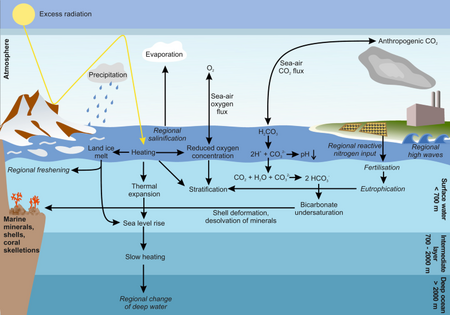
File:The Ocean A Driving Force for Weather and Climate.webm
There are many effects of climate change on oceans. One of the main ones is an increase in ocean temperatures. More frequent marine heatwaves are linked to this. The rising temperature contributes to a rise in sea levels. Other effects include ocean acidification, sea ice decline, increased ocean stratification and reductions in oxygen levels. Changes to ocean currents including a weakening of the Atlantic meridional overturning circulation are another important effect.[2] All these changes have knock-on effects which disturb marine ecosystems. The main cause of these changes is climate change due to human emissions of greenhouse gases. Carbon dioxide and methane are examples of greenhouse gases. This leads to ocean warming, because the ocean takes up most of the additional heat in the climate system.[3] The ocean absorbs some of the extra carbon dioxide in the atmosphere. This causes the pH value of the ocean to drop.[4] Scientists estimate that the ocean absorbs about 25% of all human-caused CO
2 emissions.[4]
Ocean temperature stratification is the difference in temperature between the various layers of the ocean. It increases as the ocean surface warms due to rising air temperatures.[5]:471 The decline in mixing of the ocean layers stabilizes warm water near the surface. It also reduces cold, deep water circulation. The reduced vertical mixing makes it harder for the ocean to absorb heat. So a larger share of future warming goes into the atmosphere and land. One result is an increase in the amount of energy available for tropical cyclones and other storms. Another result is a decrease in nutrients for fish in the upper ocean layers. These changes also reduce the ocean's capacity to store carbon.[6] At the same time, contrasts in salinity are increasing. Salty areas are becoming saltier and fresher areas less salty.[7]
Warmer water cannot contain the same amount of oxygen as cold water. As a result, oxygen from the oceans moves to the atmosphere. Increased thermal stratification may reduce the supply of oxygen from surface waters to deeper waters. This lowers the water's oxygen content even more.[8] The ocean has already lost oxygen throughout its water column. Oxygen minimum zones are expanding worldwide.[5]:471
These changes harm marine ecosystems, which can accelerate species extinctions[9] or cause population explosions, altering species distribution.[2] This also affects coastal fishing and tourism. Rising water temperatures will also harm various oceanic ecosystems, such as coral reefs. The direct effect is coral bleaching on these reefs, which are sensitive to even minor temperature changes, so a small increase in temperature could have a significant impact in these environments. Ocean acidification and temperature rise will also affect the productivity and distribution of species within the ocean, threatening fisheries and upsetting marine ecosystems. Loss of sea ice habitats due to warming will severely impact the many polar species that rely on it. The interactions between many of these climate change factors increase pressures on the climate system and ocean ecosystems.[2]
Changes due to rising greenhouse gas levels
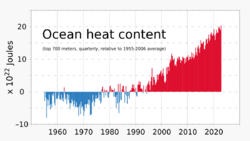
Presently (2020), atmospheric carbon dioxide (CO2) levels of more than 410 parts per million (ppm) are nearly 50% higher than preindustrial levels. These elevated levels and rapid growth rates are unprecedented in the geological record's 55 million years.[4] The source for this excess CO
2 is clearly established as human-driven, reflecting a mix of fossil fuel burning, industrial, and land-use/land-change emissions.[4] The idea that the ocean serves as a major sink for anthropogenic CO
2 has been discussed in scientific literature since at least the late 1950s.[4] Several pieces of evidence point to the ocean absorbing roughly a quarter of total anthropogenic CO
2 emissions.[4]
The latest key findings about the observed changes and impacts from 2019 include:
It is virtually certain that the global ocean has warmed unabated since 1970 and has taken up more than 90% of the excess heat in the climate system [...]. Since 1993, the rate of ocean warming has more than doubled [...]. Marine heatwaves have very likely doubled in frequency since 1982 and are increasing in intensity [...]. By absorbing more CO2, the ocean has undergone increasing surface acidification [...]. A loss of oxygen has occurred from the surface to 1000 m [...].
Rising ocean temperature
It is clear that the ocean is warming as a result of climate change, and this rate of warming is increasing.[2]:9 The global ocean was the warmest it had ever been recorded by humans in 2022.[13] This is determined by the ocean heat content, which exceeded the previous 2021 maximum in 2022.[13] The steady rise in ocean temperatures is an unavoidable result of the Earth's energy imbalance, which is primarily caused by rising levels of greenhouse gases.[13] Between pre-industrial times and the 2011–2020 decade, the ocean's surface has heated between 0.68 and 1.01 °C.[14]:1214
The upper ocean (above 700 m) is warming the fastest, but the warming trend is widespread. The majority of ocean heat gain occurs in the Southern Ocean. For example, between the 1950s and the 1980s, the temperature of the Antarctic Southern Ocean rose by 0.17 °C (0.31 °F), nearly twice the rate of the global ocean.[15]
The warming rate varies with depth: at a depth of a thousand metres the warming occurs at a rate of nearly 0.4 °C per century (data from 1981 to 2019), whereas warming occurs at only half that depth.[5]:463

Ocean heat content
The ocean temperature varies from place to place. Temperatures are higher near the equator and lower at the poles. As a result, changes in total ocean heat content best illustrate ocean warming. When compared to 1969–1993, heat uptake has increased between 1993 and 2017.[5]:457
Ocean acidification
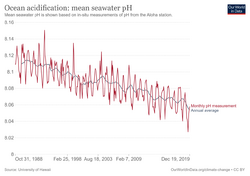
Effects on the physical environment
Sea level rise

Many coastal cities will experience coastal flooding in the coming decades and beyond.[14]:1318 Local subsidence, which may be natural but can be increased by human activity, can exacerbate coastal flooding.[20] Coastal flooding will threaten hundreds of millions of people by 2050, particularly in Southeast Asia.[20]
Changing ocean currents
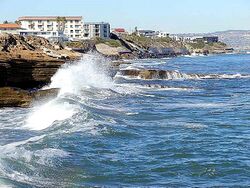
Ocean currents are caused by temperature variations caused by sunlight and air temperatures at various latitudes, as well as prevailing winds and the different densities of salt and fresh water. Warm air rises near the equator. Later, as it moves toward the poles, it cools again. Cool air sinks near the poles, but warms and rises again as it moves toward the equator. This produces Hadley cells, which are large-scale wind patterns, with similar effects driving a mid-latitude cell in each hemisphere.[21][page needed] Wind patterns associated with these circulation cells drive surface currents which push the surface water to higher latitudes where the air is colder.[21][page needed] This cools the water, causing it to become very dense in comparison to lower latitude waters, causing it to sink to the ocean floor, forming North Atlantic Deep Water (NADW) in the north and Antarctic Bottom Water (AABW) in the south.[22]
Driven by this sinking and the upwelling that occurs in lower latitudes, as well as the driving force of the winds on surface water, the ocean currents act to circulate water throughout the sea. When global warming is factored in, changes occur, particularly in areas where deep water is formed.[23] As the oceans warm and glaciers and polar ice caps melt, more and more fresh water is released into the high latitude regions where deep water forms, lowering the density of the surface water. As a result, the water sinks more slowly than it would normally.[23]
The Atlantic Meridional Overturning Circulation (AMOC) may have weakened since the preindustrial era, according to modern observations and paleoclimate reconstructions (the AMOC is part of a global thermohaline circulation), but there is too much uncertainty in the data to know for certain.[14]:1237 Climate change projections assessed in 2021 indicate that the AMOC is very likely to weaken over the course of the 21st century.[14]:1214 A weakening of this magnitude could have a significant impact on global climate, with the North Atlantic being particularly vulnerable.[2]:19
Any changes in ocean currents affect the ocean's ability to absorb carbon dioxide (which is affected by water temperature) as well as ocean productivity because the currents transport nutrients (see Impacts on phytoplankton and net primary production). Because the AMOC deep ocean circulation is slow (it takes hundreds to thousands of years to circulate the entire ocean), it is slow to respond to climate change.[24]:137
Increasing stratification
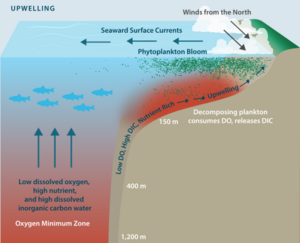
Changes in ocean stratification are significant because they can influence productivity and oxygen levels. The separation of water into layers based on density is known as stratification. Stratification by layers occurs in all ocean basins. The stratified layers limit how much vertical water mixing takes place, reducing the exchange of heat, carbon, oxygen and particles between the upper ocean and the interior.[27] Since 1970, there has been an increase in stratification in the upper ocean due to global warming and, in some areas, salinity changes.[14] The salinity changes are caused by evaporation in tropical waters, which results in higher salinity and density levels. Meanwhile, melting ice can cause a decrease in salinity at higher latitudes.[14]
Temperature, salinity and pressure all influence water density. As surface waters are often warmer than deep waters, they are less dense, resulting in stratification.[27] This stratification is crucial not just in the production of the Atlantic Meridional Overturning Circulation, which has worldwide weather and climate ramifications, but it is also significant because stratification controls the movement of nutrients from deep water to the surface. This increases ocean productivity and is associated with the compensatory downward flow of water that carries oxygen from the atmosphere and surface waters into the deep sea.[24]
Reduced oxygen levels
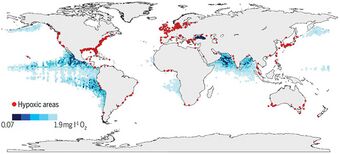
Climate change has an impact on ocean oxygen, both in coastal areas and in the open ocean.[28]
The open ocean naturally has some areas of low oxygen, known as oxygen minimum zones. These areas are isolated from the atmospheric oxygen by sluggish ocean circulation. At the same time, oxygen is consumed when sinking organic matter from surface waters is broken down. These low oxygen ocean areas are expanding as a result of ocean warming which both reduces water circulation and also reduces the oxygen content of that water, while the solubility of oxygen declines as the temperature rises.[29]
Overall ocean oxygen concentrations are estimated to have declined 2% over 50 years from the 1960s.[29] The nature of the ocean circulation means that in general these low oxygen regions are more pronounced in the Pacific Ocean. Low oxygen represents a stress for almost all marine animals. Very low oxygen levels create regions with much reduced fauna. It is predicted that these low oxygen zones will expand in future due to climate change, and this represents a serious threat to marine life in these oxygen minimum zones.[2]
The second area of concern relates to coastal waters where increasing nutrient supply from rivers to coastal areas leads to increasing production and sinking organic matter which in some coastal regions leads to extreme oxygen depletion, sometimes referred to as dead zones.[30] These dead zones are expanding driven particularly by increasing nutrient inputs, but also compounded by increasing ocean stratification driven by climate change.[2]
Oceans turning green
Satellite image analysis reveals that the oceans have been gradually turning green from blue as climate breakdown continues. The color change has been detected for a majority of the word's ocean surfaces and may be due to changing plankton populations caused by climate change.[31][32]
Changes to Earth's weather system and wind patterns
Climate change and the associated warming of the ocean will lead to widespread changes to the Earth's climate and weather system including increased tropical cyclone and monsoon intensities and weather extremes with some areas becoming wetter and others drier.[14] Changing wind patterns are predicted to increase wave heights in some areas.[33][14]:1310
Intensifying tropical cyclones
Human-induced climate change "continues to warm the oceans which provide the memory of past accumulated effects".[34] The result is a higher ocean heat content and higher sea surface temperatures. In turn, this "invigorates tropical cyclones to make them more intense, bigger, longer lasting and greatly increases their flooding rains".[34] One example is Hurricane Harvey in 2017.[34]
Salinity changes
Due to global warming and increased glacier melt, thermohaline circulation patterns may be altered by increasing amounts of freshwater released into oceans and, therefore, changing ocean salinity. Thermohaline circulation is responsible for bringing up cold, nutrient-rich water from the depths of the ocean, a process known as upwelling.[35]
Seawater consists of fresh water and salt, and the concentration of salt in seawater is called salinity. Salt does not evaporate, thus the precipitation and evaporation of freshwater influences salinity strongly. Changes in the water cycle are therefore strongly visible in surface salinity measurements, which has been known since the 1930s.[7][36]
The long term observation records show a clear trend: the global salinity patterns are amplifying in this period.[37][38] This means that the high saline regions have become more saline, and regions of low salinity have become less saline. The regions of high salinity are dominated by evaporation, and the increase in salinity shows that evaporation is increasing even more. The same goes for regions of low salinity that are becoming less saline, which indicates that precipitation is becoming more intensified.[39][5]
Sea ice decline and changes
Sea ice decline occurs more in the Arctic than in Antarctica, where it is more a matter of changing sea ice conditions.
Time scales
Many ocean-related elements of the climate system respond slowly to warming. For instance, acidification of the deep ocean will continue for millennia, and the same is true for the increase in ocean heat content.[40]:43 Similarly, sea level rise will continue for centuries or even millennia even if greenhouse gas emissions are brought to zero, due to the slow response of ice sheets to warming and the continued uptake of heat by the oceans, which expand when warmed.[40]:77
Impacts on marine life
Climate change will not only alter the overall productivity of the ocean, but it will also alter the structure of the ocean's biomass community. In general, species are expected to move towards the poles as a result. Some species have already moved hundreds of kilometres since the 1950s. Phytoplankton bloom timings are also already altering moving earlier in the season particularly in polar waters. These trends are projected to intensify with further progress of climate change.[14][failed verification]
There are additional potentially important impacts of climate change on seabirds, fish and mammals in polar regions where populations with highly specialised survival strategies will need to adapt to major changes in habitat and food supply. In addition, sea ice often plays a key role in their life cycle. In the Arctic for example, providing haul-out sites for seals and walruses, and for hunting routes for polar bears. In the Antarctic, sea bird and penguin distributions are also believed to be very sensitive to climate change, although the impacts to date vary in different regions.[14][failed verification]
Due to fall out from the 2019-2021 Pacific Northwest marine heatwave,[41] Bering Sea snow crab populations declined 84% between 2018 and 2022, a loss of 9.8 billion crabs.[42]
Calcifying organisms and ocean acidification
Coral reefs
While some mobile marine species can migrate in response to climate change, others such as corals find this much more difficult. A coral reef is an underwater ecosystem characterized by reef-building corals. Reefs are formed by colonies of coral polyps held together by calcium carbonate.[43] Coral reefs are important centres of biodiversity and vital to millions of people who rely on them for coastal protection, food and for sustaining tourism in many regions.[44]
Warm water corals are clearly in decline, with losses of 50% over the last 30–50 years due to multiple threats from ocean warming, ocean acidification, pollution and physical damage from activities such as fishing. These pressures are expected to intensify.[44]
The warming ocean surface waters can lead to bleaching of the corals which can cause serious damage and/or coral death. The IPCC Sixth Assessment Report in 2022 found that: "Since the early 1980s, the frequency and severity of mass coral bleaching events have increased sharply worldwide".[45]:416 Marine heatwaves have caused coral reef mass mortality.[45]:381 It is expected that many coral reefs will suffer irreversible changes and loss due to marine heatwaves with global temperatures increasing by more than 1.5 °C.[45]:382
Coral bleaching occurs when thermal stress from a warming ocean results in the expulsion of the symbiotic algae that resides within coral tissues. These symbiotic algae are the reason for the bright, vibrant colors of coral reefs.[46] A 1-2°C sustained increase in seawater temperatures is sufficient for bleaching to occur, which turns corals white.[47] If a coral is bleached for a prolonged period of time, death may result. In the Great Barrier Reef, before 1998 there were no such events. The first event happened in 1998 and after that, they begun to occur more frequently. Between 2016 and 2020 there were three of them.[48]
Apart from coral bleaching, the reducing pH value in oceans is also a problem for coral reefs because ocean acidification reduces coralline algal biodiversity.[49] The physiology of coralline algal calcification determines how the algae will respond to ocean acidification.[49]
Ocean productivity
The process of photosynthesis in the surface ocean releases oxygen and consumes carbon dioxide. This photosynthesis in the ocean is dominated by phytoplankton – microscopic free-floating algae. After the plants grow, bacterial decomposition of the organic matter formed by photosynthesis in the ocean consumes oxygen and releases carbon dioxide. The sinking and bacterial decomposition of some organic matter in deep ocean water, at depths where the waters are out of contact with the atmosphere, leads to a reduction in oxygen concentrations and increase in carbon dioxide, carbonate and bicarbonate.[24] This cycling of carbon dioxide in oceans is an important part of the global carbon cycle.
The photosynthesis in surface waters consumes nutrients (e.g. nitrogen and phosphorus) and transfers these nutrients to deep water as the organic matter produced by photosynthesis sinks upon the death of the organisms. Productivity in surface waters therefore depends in part on the transfer of nutrients from deep water back to the surface by ocean mixing and currents. The increasing stratification of the oceans due to climate change therefore acts generally to reduce ocean productivity. However, in some areas, such as previously ice covered regions, productivity may increase. This trend is already observable and is projected to continue under current projected climate change.[14][failed verification] In the Indian Ocean for example, productivity is estimated to have declined over the past sixty years due to climate warming and is projected to continue.[50]
Ocean productivity under a very high emission scenario (RCP8.5) is very likely to drop by 4-11% by 2100.[5]:452 The decline will show regional variations. For example, the tropical ocean NPP will decline more: by 7–16% for the same emissions scenario.[5]:452 Less organic matter will likely sink from the upper oceans into deeper ocean layers due to increased ocean stratification and a reduction in nutrient supply.[5]:452 The reduction in ocean productivity is due to the "combined effects of warming, stratification, light, nutrients and predation".[5]:452
Effects on fisheries
Harmful algal blooms
Although the drivers of harmful algal blooms (HABs) are poorly understood, they appear to have increased in range and frequency in coastal areas since the 1980s.[2]:16 This is the result of human induced factors such as increased nutrient inputs (nutrient pollution) and climate change (in particular the warming of water temperatures).[2]:16 The parameters that affect the formation of HABs are ocean warming, marine heatwaves, oxygen loss, eutrophication and water pollution.[51]:582 These increases in HABs are of concern because of the impact of their occurrence on local food security, tourism and the economy.[2]:16
It is however also possible that the perceived increase in HABs globally is simply due to more severe bloom impacts and better monitoring and not due to climate change.[45]:463
Marine mammals
Some effects on marine mammals, especially those in the Arctic, are very direct such as loss of habitat, temperature stress, and exposure to severe weather. Other effects are more indirect, such as changes in host pathogen associations, changes in body condition because of predator–prey interaction, changes in exposure to toxins and CO
2 emissions, and increased human interactions.[52] Despite the large potential impacts of ocean warming on marine mammals, the global vulnerability of marine mammals to global warming is still poorly understood.[53]
Marine mammals have evolved to live in oceans, but climate change is affecting their natural habitat.[54][55][56][57] Some species may not adapt fast enough, which might lead to their extinction.[58]
It has been generally assumed that the Arctic marine mammals were the most vulnerable in the face of climate change given the substantial observed and projected decline in Arctic sea ice. However, research has shown that the North Pacific Ocean, the Greenland Sea and the Barents Sea host the species that are most vulnerable to global warming.[53] The North Pacific has already been identified as a hotspot for human threats for marine mammals[59] and is now also a hotspot for vulnerability to global warming. Marine mammals in this region will face double jeopardy from both human activities (e.g., marine traffic, pollution and offshore oil and gas development) and global warming, with potential additive or synergetic effects. As a result, these ecosystems face irreversible consequences for marine ecosystem functioning.[53]
Marine organisms usually tend to encounter relatively stable temperatures compared to terrestrial species and thus are likely to be more sensitive to temperature change than terrestrial organisms.[60] Therefore, the ocean warming will lead to the migration of increased species, as endangered species look for a more suitable habitat. If sea temperatures continue to rise, then some fauna may move to cooler water and some range-edge species may disappear from regional waters or experience a reduced global range.[60] Change in the abundance of some species will alter the food resources available to marine mammals, which then results in marine mammals' biogeographic shifts. Furthermore, if a species is unable to successfully migrate to a suitable environment, it will be at risk of extinction if it cannot adapt to rising temperatures of the ocean.
Arctic sea ice decline leads to loss of the sea ice habitat, elevations of water and air temperature, and increased occurrence of severe weather. The loss of sea ice habitat will reduce the abundance of seal prey for marine mammals, particularly polar bears.[61] Sea ice changes may also have indirect effects on animal heath due to changes in the transmission of pathogens, impacts on animals' body condition due to shifts in the prey-based food web, and increased exposure to toxicants as a result of increased human habitation in the Arctic habitat.[62]
Sea level rise is also important when assessing the impacts of global warming on marine mammals, since it affects coastal environments that marine mammal species rely on.[63]
Polar bears
Seals
Seals are another marine mammal that are susceptible to climate change.[58] Much like polar bears, some seal species have evolved to rely on sea ice. They use the ice platforms for breeding and raising young seal pups. In 2010 and 2011, sea ice in the Northwest Atlantic was at or near an all-time low and harp seals as well as ringed seals that bred on thin ice saw increased death rates.[64][65] Antarctic fur seals in South Georgia in the South Atlantic Ocean saw extreme reductions over a 20-year study, during which scientists measured increased sea surface temperature anomalies.[66]
Dolphins
Dolphins are marine mammals with broad geographic extent, making them susceptible to climate change in various ways. The most common effect of climate change on dolphins is the increasing water temperatures across the globe.[67] This has caused a large variety of dolphin species to experience range shifts, in which the species move from their typical geographic region to cooler waters.[68][69] Another side effect of increasing water temperatures is the increase in harmful algae blooms, which has caused a mass die-off of bottlenose dolphins.[67]
Climate change has had a significant impact on various dolphin species. For example: In the Mediterranean, increased sea surface temperatures, salinity, upwelling intensity, and sea levels have led to a reduction in prey resources, causing a steep decline in the short-beaked common dolphin subpopulation in the Mediterranean, which was classified as endangered in 2003.[70] At the Shark Bay World Heritage Area in Western Australia, the local population of the Indo-Pacific bottlenose dolphin had a significant decline following a marine heatwave in 2011.[71] River dolphins are highly affected by climate change as high evaporation rates, increased water temperatures, decreased precipitation, and increased acidification occur.[68][72]
North Atlantic right whales
Potential feedback effects
Methane release from methane clathrate
Rising ocean temperatures also have the potential to impact methane clathrate reservoirs located under the ocean floor sediments. These trap large amounts of the greenhouse gas methane, which ocean warming has the potential to release. However, it is currently considered unlikely that gas clathrates (mostly methane) in subsea clathrates will lead to a "detectable departure from the emissions trajectory during this century".[40]:107
In 2004 the global inventory of ocean methane clathrates was estimated to occupy between one and five million cubic kilometres.[73]
See also
References
External links
 | 0.00      (0 votes) (0 votes) |
 KSF
KSF
